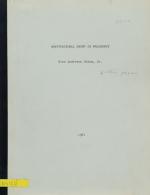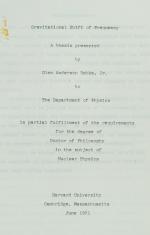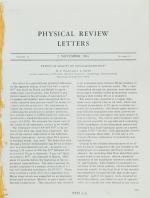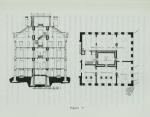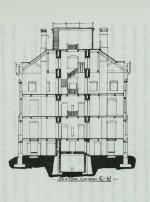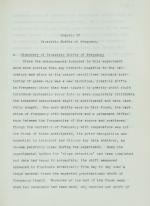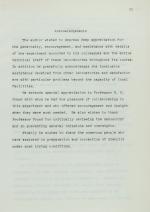Pound, Apparent Weight of Photons.
Apparent Weight of Photons / Effect of Gravity on Nuclear Resonance [Both original offprints of these landmark physics – experiments are loosely inserted inside something really scarce: the original, printed thesis of Glen Anderson Rebka, Jr.: “Gravitational Shift of Frequency” – with a handwritten note in pencil on cover: “& other papers” (these other papers are the original offprints described in this position here)].
First Edition of both offprints and the original edition of Rebka’s Thesis. Cambridge, Harvard, 1960-1964. Quarto (20 cm x27 cm). Pagination: “Apparent Weight of Photons” pages 337 – 341 from Physical Review Letters (April 1, 1960) / “Effect of Gravity on Nuclear Resonance″page 539 – 540 from Physical Review Letters (November 2nd, 1964). Original Offprint / Stapled. Very good condition with some minor signs of wear only. Even though no sign of it, these original offprints come from the library of Robert Vivian Pound. The two original offprints are accompanied by xeroxed reviews of the “Clock Paradox” and the Pound-Rebka-experiments “dependence of the Mössbauer effect in Fe” by C.W.Sherwin. Also included is a xerox of the original Pound-Rebka Experiment “Gravitational Red-Shift in Nuclear Resonance”.
Glen Anderson Rebka Jr. (September 19, 1931, Cincinnati – January 13, 2015, Laramie) was an American physicist.
Rebka attained a doctorate 1961 at Harvard, where he began study in 1953. Starting from 1961 he was at Yale University and starting from 1970 at the University of Wyoming, where he was from 1983 to 1991 department head of the physics faculty and is since 1997 professor emeritus. In addition to his academic career he did much work as an experimental elementary-particle physicist at Los Alamos National Laboratory. At the University of Wyoming he built up the astrophysics faculty.
In 1960 Robert Pound carried out together with his assistant Glen Rebka an experiment, the Pound–Rebka experiment, using the Mössbauer effect to measure the gravitational redshift of the radiation from a gamma source in the gravitation field of planet Earth. Pound and Rebka used at Harvard University the Jefferson tower, which is only 22.6 meters tall. The work was part of Rebka’s thesis with Pound as thesis advisor. Pound and Rebka received in 1965 the Eddington medal of the Royal Astronomical Society. (Wikipedia)
The Pound–Rebka experiment was an experiment in which gamma rays were emitted from the top of a tower and measured by a receiver at the bottom of the tower. The purpose of the experiment was to test Albert Einstein’s theory of general relativity by showing that photons gain energy when traveling toward a gravitational source (the Earth). It was proposed by Robert Pound and his graduate student Glen A. Rebka Jr. in 1959, and was the last of the classical tests of general relativity to be verified (in the same year). It is a gravitational redshift experiment, which measures the change of frequency of light moving in a gravitational field. In this experiment, the frequency shift was a blueshift toward a higher frequency. Equivalently, the test demonstrated the general relativity prediction that clocks should run at different rates in different places of a gravitational field. It is considered to be the experiment that ushered in an era of precision tests of general relativity. (Wikipedia)
Robert Vivian Pound (May 16, 1919 – April 12, 2010) was a Canadian-American physicist who helped discover nuclear magnetic resonance (NMR) and who devised the famous Pound–Rebka experiment supporting general relativity. He became a tenured professor of physics at Harvard without ever having received a graduate degree.
Pound was born in Ridgeway, Ontario. In 1946 Pound and collaborators Edward Purcell and Henry Torrey adapted the Rad Lab techniques—widely used to this day in radar and communications—to detect nuclear magnetic resonance in condensed matter. Soon NMR became a standard analytical tool in chemistry, biology, and physics, and the “Pound box” marginal oscillator became the standard NMR detector.
The discovery of NMR won the Nobel Prize in physics in 1952, though, due to the limitation on the number of recipients and the simultaneous achievements of Felix Bloch’s group, only two recipients were designated. In his address to recipient Ed Purcell, Professor Hulthén nevertheless celebrated the “very interesting experiment you performed together with Dr. Pound”, making Pound one of only two collaborators explicitly named in the speech. Pound received the National Medal of Science in 1990 for his lifetime contributions to the field of physics. Pound was the Mallinckrodt Professor of Physics emeritus at Harvard University. He was a member of the class of 1941 at the University at Buffalo. Pound’s name is also attached to the Pound–Drever–Hall technique used to lock the frequency of a laser on a stable optical cavity. (Wikipedia)
- Keywords: Collection Science – Rare · Nuclear Physics · Physics – Rare · Pound-Rebka Experiment · Pound, Robert Vivian · Rebka Jr., G.A.
- Language: English
- Inventory Number: 29919AB
EUR 2.800,--
© 2024 Inanna Rare Books Ltd. | Powered by HESCOM-Software






